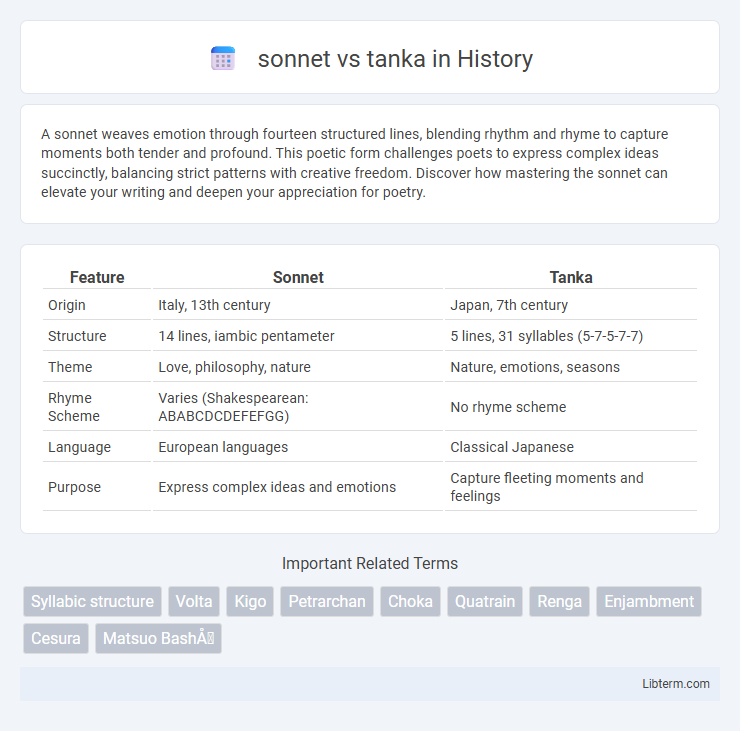A sonnet weaves emotion through fourteen structured lines, blending rhythm and rhyme to capture moments both tender and profound. This poetic form challenges poets to express complex ideas succinctly, balancing strict patterns with creative freedom. Discover how mastering the sonnet can elevate your writing and deepen your appreciation for poetry.
Table of Comparison
| Feature | Sonnet | Tanka |
|---|---|---|
| Origin | Italy, 13th century | Japan, 7th century |
| Structure | 14 lines, iambic pentameter | 5 lines, 31 syllables (5-7-5-7-7) |
| Theme | Love, philosophy, nature | Nature, emotions, seasons |
| Rhyme Scheme | Varies (Shakespearean: ABABCDCDEFEFGG) | No rhyme scheme |
| Language | European languages | Classical Japanese |
| Purpose | Express complex ideas and emotions | Capture fleeting moments and feelings |
Introduction to Sonnets and Tankas
Sonnets, traditionally composed of 14 lines with a specific rhyme scheme, originated in Italy and are widely used in English literature to explore themes of love, nature, and philosophy. Tankas, a classic form of Japanese poetry, consist of five lines with a 5-7-5-7-7 syllable pattern, emphasizing emotional depth and brevity. Both forms highlight cultural expressions through structured verse but differ significantly in length, rhythm, and thematic focus.
Historical Origins and Evolution
Sonnet originated in 13th-century Italy, credited to poet Giacomo da Lentini, and gained prominence through Petrarch's works, evolving into distinct forms such as the Petrarchan and Shakespearean sonnets across Europe. Tanka, rooted in 7th-century Japan, emerged from early waka poetry, emphasizing concise, emotional expression with a fixed 5-7-5-7-7 syllabic structure, preserving traditional aesthetics through centuries of Japanese literature. Both forms illustrate evolving cultural values: sonnets adapted to Western Renaissance humanism while tanka maintained its connection to nature and personal reflection in Japanese art.
Structural Differences
Sonnets consist of 14 lines typically written in iambic pentameter, organized into three quatrains followed by a final couplet, with specific rhyme schemes such as Shakespearean (ABABCDCDEFEFGG) or Petrarchan (ABBAABBACDCDCD). Tanka is a traditional Japanese form with 31 syllables arranged in five lines following a 5-7-5-7-7 syllabic pattern, without rhyme. These distinct structural elements influence the rhythm, length, and thematic development unique to each poetic form.
Rhyme Scheme and Meter
Sonnets typically follow a strict rhyme scheme such as ABABCDCDEFEFGG, with iambic pentameter consisting of 10 syllables per line, emphasizing rhythm and structured meter. Tanka poems lack a rhyme scheme entirely and rely on a syllabic pattern of 5-7-5-7-7, focusing on syllable count rather than metrical feet. The sonnet's rigid formal structure contrasts with the tanka's concise syllabic flow, reflecting distinct poetic traditions.
Thematic Focus and Subject Matter
Sonnet poetry often explores themes of love, mortality, and nature through intricate rhyme schemes and structured quatrains, emphasizing emotional depth and philosophical reflection. Tanka poetry traditionally centers on personal emotions, seasons, and fleeting moments, using concise imagery and a 5-7-5-7-7 syllable pattern to evoke subtle feelings and natural beauty. Thematic focus in sonnets tends toward universal and dramatic subjects, while tankas emphasize intimate, immediate experiences grounded in Japanese cultural aesthetics.
Use of Imagery and Language
Sonnets employ intricate metaphors and elevated diction to convey complex emotions and ideas within a strict 14-line structure, often using iambic pentameter to enhance rhythm and depth. Tanka, a concise five-line poem with a 5-7-5-7-7 syllable pattern, relies on vivid, sensory imagery drawn from nature and personal reflection, creating an intimate and immediate emotional impact. Both forms use imagery to evoke emotions, but sonnets emphasize elaborate language and logical progression, while tanka prioritizes brevity and evocative simplicity.
Cultural Significance
Sonnets hold a prominent place in Western literature, symbolizing the Renaissance's celebration of human emotion and intellectual artistry, especially through figures like Shakespeare. Tanka, with roots extending over 1,300 years in Japanese culture, embodies brevity and deep emotional expression tied closely to nature and seasons, reflecting the aesthetic principles of wabi-sabi and mono no aware. Both forms serve not only as poetic expressions but as cultural artifacts that encapsulate distinct historical values and philosophies in their societies.
Famous Examples in Literature
Shakespeare's Sonnet 18, "Shall I compare thee to a summer's day?" epitomizes sonnet form's lyrical power and enduring popularity in English literature. Matsuo Basho's haiku-inspired tanka, such as "An old silent pond / A frog jumps into the pond-- / Splash! Silence again," showcases the concise emotional depth characteristic of traditional Japanese poetry. Both forms emphasize vivid imagery and emotional reflection, yet sonnets often explore romantic themes through structured rhyme schemes, while tankas expand on fleeting moments with a 5-7-5-7-7 syllabic pattern.
Writing Techniques and Tips
Sonnets utilize structured rhyme schemes such as the Shakespearean (ABABCDCDEFEFGG) or Petrarchan (ABBAABBACDCDCD), emphasizing iambic pentameter to create rhythm and musicality. Tanka employs a 5-7-5-7-7 syllabic pattern without rhyme, focusing on evocative imagery and emotional depth through concise language. Writers aiming to master sonnets should concentrate on meter consistency and thematic development, while tanka poets benefit from vivid sensory details and subtle emotional shifts within limited syllables.
Choosing Between Sonnet and Tanka
Choosing between sonnet and tanka depends on the desired poetic structure and length, as sonnets consist of 14 lines with a strict rhyme scheme, while tankas are shorter, five-line poems with a 5-7-5-7-7 syllable pattern. Sonnets are ideal for exploring complex themes and emotions through extended metaphor and argumentative progression, whereas tankas emphasize brevity and vivid imagery, often reflecting nature and personal feelings. Consider the purpose of the poem and the cultural resonance, with sonnets rooted in Western tradition and tankas originating from Japanese classical poetry.
sonnet Infographic

 libterm.com
libterm.com